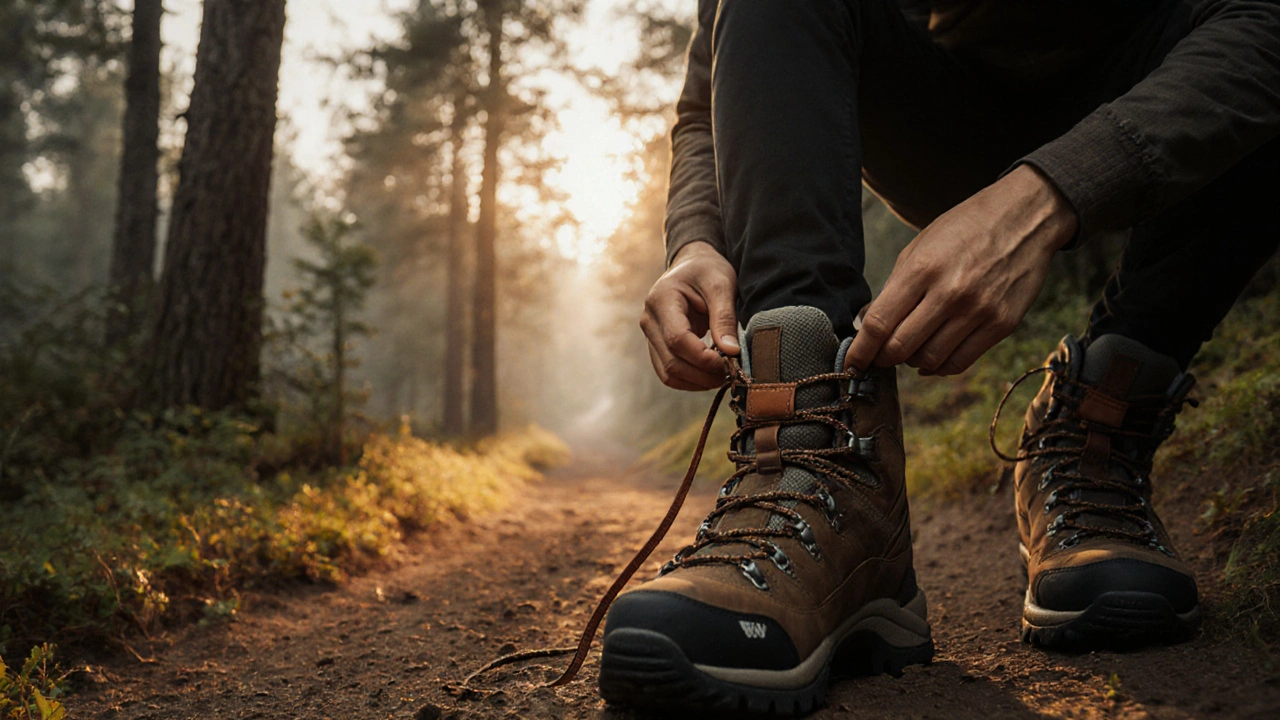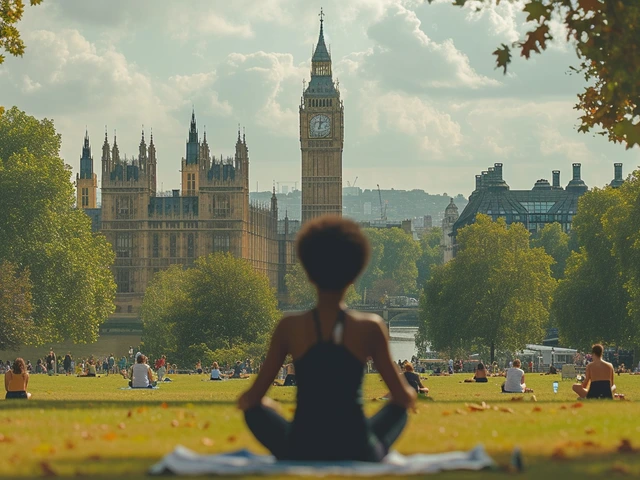
Hiking Calories Burned Calculator
Estimate how many calories you burn during a hike based on your weight, hike duration, and terrain difficulty. The results are approximate and can vary based on individual factors.
Calories Burned Result
Enter your details above to see your estimated calorie burn.
When you lace up your boots, Hiking is a form of outdoor walking on trails or natural terrain that varies in difficulty and duration becomes more than a weekend hobby-it turns into a powerful health booster. Whether you’re strolling a gentle forest path or tackling a steep mountain ridge, moving through nature on a consistent basis can reshape your body, lift your mood, and protect you from chronic disease. Below you’ll find a step‑by‑step look at why regular hiking matters and how to make the most of each trek.
What Counts as Regular Hiking?
Most experts agree that “regular” means at least three sessions per week, each lasting 30‑60 minutes. The key is consistency, not intensity. A moderate pace that raises your heart rate but still lets you hold a conversation qualifies as aerobic activity. For beginners, a 2‑mile loop on level ground is enough; seasoned trekkers might push to 10‑plus miles with elevation gain.
Physical Health Benefits
Every step you take triggers a cascade of physiological changes. Below are the biggest physical payoffs of making hiking a habit.
Cardiovascular Health
Cardiovascular health refers to the efficiency of the heart, blood vessels, and lungs in delivering oxygen to tissues improves dramatically with regular hiking. Studies from the American Heart Association show that a 45‑minute hike three times a week can lower resting heart rate by 5‑10 beats per minute and reduce LDL cholesterol by up to 8%.
Muscle Strength and Endurance
Negotiating uneven terrain engages the quadriceps, hamstrings, glutes, and calves. Over time, these muscles grow stronger, and you’ll notice better balance and fewer joint aches. A 2023 meta‑analysis reported a 12% increase in lower‑body muscle endurance after 12 weeks of thrice‑weekly hikes.
Bone Density
Bone density measures the amount of mineral matter per cubic centimeter of bone responds positively to weight‑bearing activities. Hiking stimulates osteoblast activity, especially in post‑menopausal women, reducing osteoporosis risk by roughly 25% according to a longitudinal study from the University of Sydney.
Weight Management
Burning 300‑600 calories per session, depending on speed and incline, helps maintain a healthy body mass index. Pairing hikes with a balanced diet can create a caloric deficit of 500‑700 calories per week, enough for steady, sustainable weight loss.
Immune System Support
Spending time outdoors exposes you to a diverse array of microbes that train the immune system the body’s defense network of cells, tissues, and organs. A 2022 trial found that participants who hiked three times weekly had fewer sick days-about 30% less-than sedentary peers.
Vitamin D Synthesis
Sunlight triggers skin production of Vitamin D a fat‑soluble vitamin essential for calcium absorption and bone health. Even 15 minutes of midday sun during a hike can raise serum vitamin D levels by 10‑15 ng/mL, supporting both bone health and immune function.
Mental and Emotional Benefits
Beyond the body, hiking nurtures the mind in ways that gyms rarely match.
Stress Hormone Reduction
Physical activity lowers cortisol, the primary stress hormone. A 2021 study showed a 20% drop in cortisol after a moderate hike, with the effect lasting up to six hours post‑exercise.
Endorphin Release
During sustained aerobic effort, the brain releases endorphins natural pain‑relieving chemicals that also boost mood. Hikers often describe the “runner’s high” as a subtle euphoria that reduces anxiety and improves overall wellbeing.
Mental Health Boost
Regular exposure to green spaces correlates with lower rates of depression and anxiety. The National Institute of Mental Health reports that adults who hike at least once weekly have a 33% lower odds of developing major depressive disorder.
Cognitive Sharpness
Walking in nature raises blood flow to the prefrontal cortex, sharpening attention and memory. A 2019 experiment demonstrated a 10‑minute forest walk improved working memory scores by 15% compared with an indoor treadmill session.
Improved Sleep
Physical fatigue combined with natural light cues helps regulate circadian rhythms, leading to deeper, more restorative sleep. Participants in a 2020 sleep‑study reported falling asleep 30‑45 minutes faster after three consecutive evenings of hiking.

How Often Should You Hit the Trails?
Here’s a simple framework to turn hiking into a habit:
- Beginner (0‑6 months): 2‑3 hikes per week, 30‑45 minutes each, low‑grade paths.
- Intermediate (6‑18 months): 3‑4 hikes per week, 45‑60 minutes, moderate elevation gain (200‑500 ft per hike).
- Advanced (18+ months): 4‑5 hikes per week, 60‑90 minutes, include one long hike (2+ hours) and one high‑intensity hill or stair climb each week.
Listen to your body-if you feel persistent soreness or fatigue, scale back intensity or add a rest day.
Safety Tips and Getting Started
Even a leisurely stroll can become risky without basic precautions.
- Footwear: Invest in waterproof hiking boots with good ankle support and a grippy sole.
- Hydration: Carry at least 0.5 L of water per hour; add electrolytes for hikes over 90 minutes.
- Weather Check: Look up forecasts on the Bureau of Meteorology (Australia) or National Weather Service (US) before heading out.
- Trail Knowledge: Use apps like AllTrails or local park websites to gauge difficulty, length, and elevation.
- First‑Aid Kit: Pack bandages, blister pads, antihistamine, and a whistle.
Never hike alone in remote areas-pair up or let someone know your route and expected return time.

Sample Weekly Hiking Plan
Below is a printable schedule that balances cardio, strength, and recovery.
| Day | Activity | Duration | Focus |
|---|---|---|---|
| Monday | Easy trail (flat) | 30 min | Cardio & Warm‑up |
| Tuesday | Rest or gentle yoga | - | Recovery |
| Wednesday | Moderate hill repeat (5 × 2 min uphill) | 45 min | Leg strength & Endurance |
| Thursday | Short nature walk | 30 min | Mindful exposure |
| Friday | Rest | - | Recovery |
| Saturday | Long hike (10‑12 km, mixed terrain) | 90‑120 min | Stamina & Vitamin D |
| Sunday | Gentle stretch & foam roll | 20 min | Flexibility |
Adjust distances and elevation based on your local geography. The pattern-alternating effort and rest-keeps hormones balanced and prevents overuse injuries.
Frequently Asked Questions
How many calories can I burn on a typical hike?
A 155‑lb (70 kg) person burns roughly 300‑400 calories during a 60‑minute moderate hike on mixed terrain. Heavier individuals or steeper climbs can increase the burn to 500‑600 calories.
Is hiking better than treadmill walking for heart health?
Yes. The varied inclines, uneven surfaces, and natural respiratory patterns of hiking raise heart rate variability more effectively than a steady‑state treadmill session, delivering greater cardiovascular adaptations.
Can I hike if I have arthritis?
Low‑impact trails with smooth surfaces are often recommended. The gentle loading can improve joint lubrication and reduce stiffness, but always consult your rheumatologist before starting a new routine.
Do I need a special diet to support regular hiking?
Focus on balanced meals with complex carbs, lean protein, and healthy fats. Adding a handful of nuts or a banana before a hike can sustain energy, while post‑hike protein aids muscle repair.
What’s the best time of day for a hike?
Early morning (6‑9 am) offers cooler temperatures, lower UV exposure, and quieter trails. If you’re after maximum Vitamin D synthesis, aim for mid‑day sun, but wear sunscreen.
Ready to strap on those boots? The health benefits of hiking are waiting on the next trail. Start small, stay consistent, and let nature do the rest.





